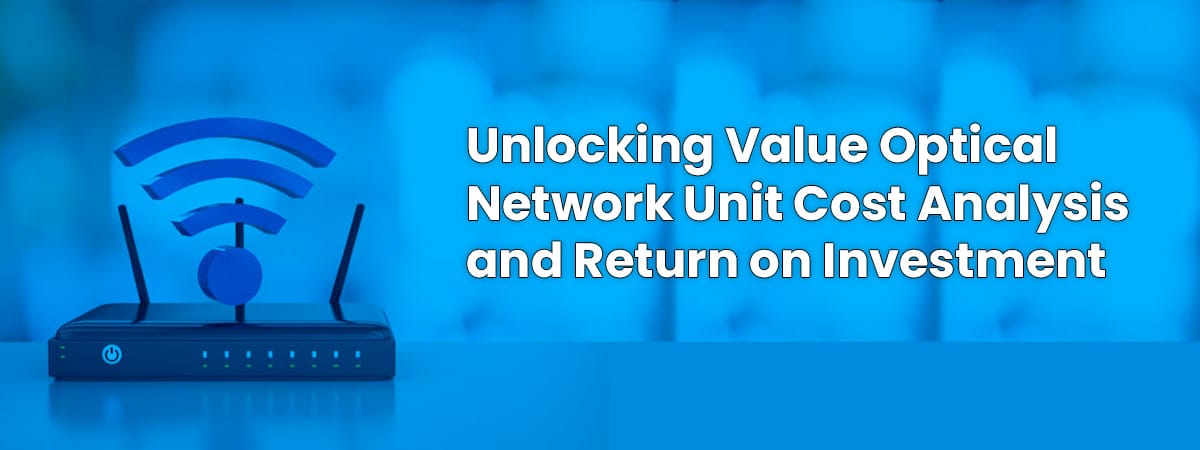Introduction
As organizations strive to enhance their network infrastructure, Optical Network Units (ONUs) have become crucial components in delivering high-speed connectivity to end-users. When considering the deployment of ONUs, conducting a comprehensive cost analysis and evaluating the return on investment (ROI) is essential. In this article, we will explore the significance of ONU cost analysis and ROI assessment, highlighting key factors to consider and the potential benefits organizations can gain from investing in ONUs.
- Upfront Costs and Total Cost of Ownership (TCO)
When evaluating the cost of deploying ONUs, it is important to consider both upfront costs and the Total Cost of Ownership (TCO). Upfront costs include the price of the ONUs, installation, and associated hardware. However, TCO encompasses all costs incurred throughout the lifespan of the ONUs, including maintenance, upgrades, power consumption, and potential replacement costs.
By conducting a thorough cost analysis, organizations can accurately assess the initial investment required and evaluate the long-term financial implications. Comparing different ONU options and calculating the TCO allows organizations to make informed decisions and choose cost-effective solutions that align with their budgetary requirements.
- Operational Efficiency and Cost Savings
Investing in high-quality ONUs can yield significant operational efficiencies and cost savings. ONUs with advanced features, such as remote management capabilities, enable organizations to monitor and troubleshoot network issues more efficiently, reducing the need for on-site visits and minimizing maintenance costs. Additionally, ONUs that support bandwidth optimization and QoS (Quality of Service) features allow for effective resource utilization, enabling organizations to serve a larger user base without additional infrastructure investments.
Furthermore, the increased speed and reliability of fiber-based broadband services delivered through ONUs can positively impact productivity and user satisfaction. This, in turn, can lead to improved business outcomes and potential revenue growth.
- Scalability and Future-Proofing
Scalability is a critical factor in cost analysis and ROI assessment. Organizations should consider whether the selected ONUs can accommodate future growth and evolving network requirements. Scalable ONUs enable seamless expansion without significant disruption or the need for expensive infrastructure upgrades. By investing in scalable ONUs, organizations can avoid costly retrofits or replacements in the future, thereby enhancing the ROI.
Future-proofing is equally important. Assessing the ability of ONUs to support emerging technologies and industry standards ensures longevity and minimizes the risk of premature obsolescence. By selecting ONUs that are compatible with upcoming advancements, organizations can protect their investment and avoid the need for frequent hardware replacements.
- Enhanced User Experience and Competitive Advantage
Investing in ONUs can significantly enhance the end-user experience, providing faster and more reliable internet connectivity. This improved user experience can lead to increased customer satisfaction and loyalty. Satisfied users are more likely to stay with a service provider, reducing customer churn and the associated costs of acquiring new customers.
Additionally, organizations that deliver superior broadband services through advanced ONUs can gain a competitive advantage in the market. By offering reliable and high-speed connectivity, businesses can differentiate themselves from competitors and attract new customers who prioritize a seamless digital experience.
- ROI Calculation and Measurement
Calculating the ROI of ONUs involves comparing the financial benefits gained from the investment against the costs incurred. Organizations can measure ROI by considering factors such as increased revenue, cost savings, productivity gains, and customer retention rates.
ROI can be assessed over a specific time period, taking into account the expected lifespan of the ONUs. Regular monitoring and analysis of key performance indicators (KPIs) related to network performance, operational efficiency, and customer satisfaction can provide insights into the effectiveness of the investment and allow for adjustments or optimizations if necessary.
Conclusion
Conducting a comprehensive cost analysis and evaluating the ROI of Optical Network Units (ONUs) is crucial for organizations looking to optimize their network infrastructure investments. By considering upfront costs, TCO, operational efficiencies, scalability, future-proofing, user experience enhancements, and competitive advantages, organizations can make informed decisions and maximize the value of their investment. By selecting cost-effective and advanced ONUs, organizations can achieve a solid ROI, improve network performance, and position themselves for long-term success in the digital landscape.
